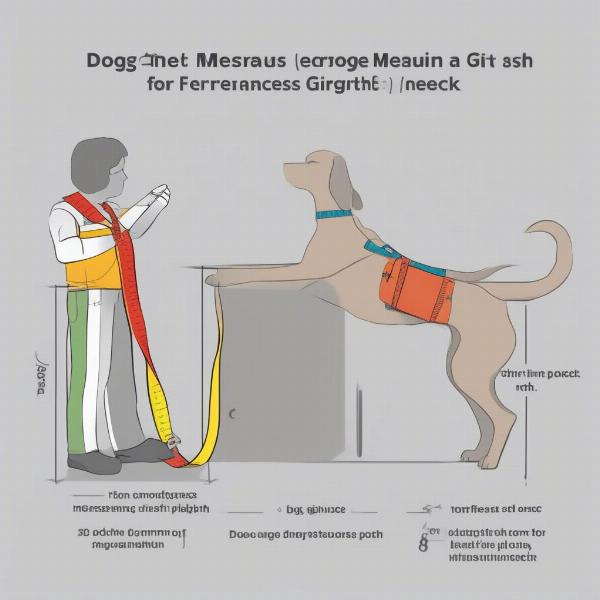A big dog harness is more than just a stylish accessory; it’s a crucial piece of equipment for ensuring your furry friend’s safety and comfort. Whether you’re embarking on daily walks, engaging in exciting adventures, or simply managing your dog’s strength, the right harness can make all the difference. Choosing the perfect big dog harness involves considering factors like size, breed, activity level, and even your dog’s individual personality. This guide provides you with everything you need to know about selecting the ideal big dog harness for your beloved companion.
Types of Big Dog Harnesses
Navigating the world of big dog harnesses can feel overwhelming with so many options available. Let’s break down the most common types:
Back-Clip Harnesses
These harnesses feature a leash attachment point on the dog’s back. They’re a good choice for well-trained dogs who don’t pull excessively. Back-clip harnesses distribute pressure evenly across the chest and back, minimizing strain on the neck.
Front-Clip Harnesses
Designed for dogs prone to pulling, front-clip harnesses discourage this behavior by gently steering the dog back towards you when they pull on the leash. This can be helpful for training purposes.
Dual-Clip Harnesses
Offering the best of both worlds, dual-clip harnesses have leash attachment points on both the front and back. This versatility allows you to adjust the leash attachment based on the situation.
No-Pull Harnesses
These specialized harnesses are designed to minimize pulling by applying gentle pressure to specific points on the body, such as the chest or under the legs. They are particularly helpful for strong, energetic dogs.
Finding the Perfect Fit for Your Big Dog
Choosing the right size is crucial for ensuring your dog’s comfort and the harness’ effectiveness.
Measuring Your Dog
Use a flexible measuring tape to determine your dog’s girth (around the widest part of the chest, behind the front legs) and neck circumference. Consult the manufacturer’s size chart for each specific harness, as sizing can vary between brands. A snug fit is essential, but ensure you can fit two fingers between the harness and your dog’s body.
Considering Breed and Build
Certain breeds have specific body shapes that may require adjustments in harness selection. Deep-chested breeds like Great Danes might benefit from harnesses designed to prevent slipping. Similarly, bulky breeds like Bulldogs may require harnesses with wider straps for optimal comfort.
 Measuring a Dog for a Harness
Measuring a Dog for a Harness
Material Matters: Durability and Comfort
Big dog harnesses are constructed from various materials, each with its pros and cons.
Nylon
Nylon harnesses are durable, lightweight, and easy to clean, making them a popular choice for active dogs.
Leather
Leather harnesses offer a classic look and exceptional durability. They can be more expensive but offer a premium feel.
Neoprene
Neoprene harnesses are padded and water-resistant, offering extra comfort and making them suitable for swimming and water activities.
“When selecting a harness for a large breed, always prioritize a secure fit and durable materials,” advises Dr. Emily Carter, DVM, a leading veterinary expert specializing in canine care. “A well-fitting harness can prevent injuries and ensure your dog’s safety during walks and other activities.”
Beyond the Basics: Additional Features
Some harnesses offer additional features to enhance safety and functionality.
- Reflective strips: Improve visibility during nighttime walks.
- Handles: Provide extra control in challenging situations.
- ID pockets: Allow you to store identification tags or medical information.
“Remember, the right harness is an investment in your dog’s well-being,” adds certified dog trainer, Mark Johnson. “Take the time to find the perfect fit and style for your furry friend’s needs.”
Conclusion
Choosing the right big dog harness is an essential part of responsible pet ownership. By considering your dog’s size, breed, activity level, and the type of harness best suited to their needs, you can ensure their safety, comfort, and well-being. Investing in a big dog leather harness that fits well and is made from durable materials will make walks and other activities more enjoyable for both you and your beloved companion.
FAQ
- How do I know if my dog’s harness fits correctly? You should be able to fit two fingers comfortably between the harness and your dog’s body.
- What type of harness is best for a dog that pulls? A front-clip or no-pull harness can help discourage pulling.
- Are leather harnesses good for big dogs? Leather harnesses offer excellent durability and a classic look, making them a good choice for big dogs.
- What is the best material for a big dog harness? Nylon, leather, and neoprene are all popular choices, each offering different benefits.
- How often should I clean my dog’s harness? Clean your dog’s harness regularly, especially if it gets dirty or wet.
- Can I leave a harness on my dog all the time? It’s generally not recommended to leave a harness on your dog all the time.
- What should I do if my dog’s harness is causing chafing? Adjust the fit or try a different material or style.
ILM Dog is your one-stop resource for expert advice on dog breeds, health, training, nutrition, grooming, and much more. We provide practical tips and valuable insights to help you navigate every aspect of dog ownership. From choosing the right breed to ensuring your dog’s lifelong health and happiness, ILM Dog is here to support you. Contact us today for personalized guidance: Email: [email protected], Phone: +44 20-3965-8624.